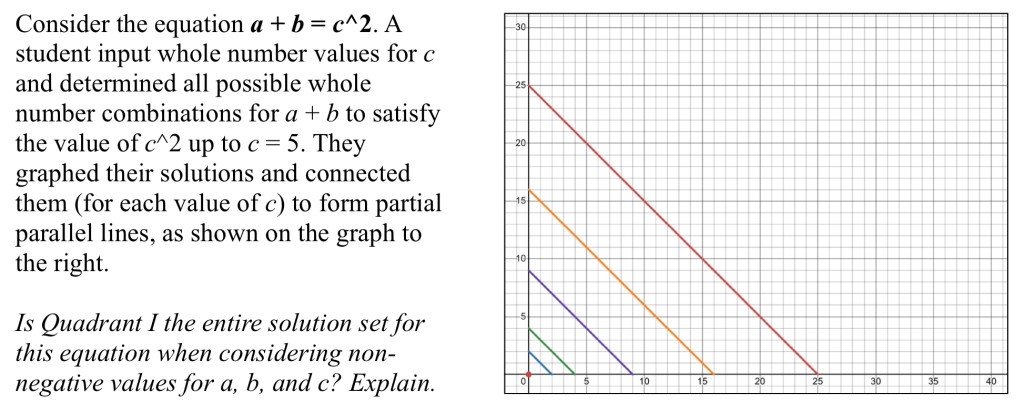Confusing Bonus Question
2 Answers
Yes, Quadrant I provides the entire solution set for this question. Indeed for any given $c$, if we let $x=a$ and $y=b$, then $a+b=c^2$, translates to
\[x+y=c^2 \Rightarrow y=-x+c^2\]
which is a line with slope $m=-1$, and $x$-intercept and $y$-intercept are both $c^2$.
For example for $c=5$ you get
\[y=-x+25\]
which is the question of the red line in the image.
-
I think the solutions of the given equation are triples (a,b,c), not pairs (a,b). So the solution set is not Quadrant I, but a 2-dimensional submanifold of $\R^3$, the segment from (c², 0, c) to (0, c², c), for each allowed value of c.
According to the problem statement, I would say that the solutions to the equation are triples $(a,b,c)$, rather than pairs $(a,b)$. So the solution set is $\{ (a, c²-a, c) ~;~ 0 \le a \le c², c \in \R_+ \} = \{ (x, y, \sqrt{x+y}) ~;~ x,y\in \R_+ \} $.
This is a subset of $\R_+^3\subset \R^3$, not of $\R²$, although it is two-dimensional: For each allowed value of $c\in\R_+$, for example $a$ can be chosen in the interval $[0, c²]$ and b is determined as $c²-a$ (or reciprocally). That is, the solutions form the segment (straight line) from $(0, c², c)$ to $(c²,0,c)$. Glueing all these subsets together yields "the first quadrant raised to the height" $z = \sqrt{x+y}$ above a point $(x,y,0)$ on the $\{ z = 0 \}$ plane.
According to the problem statement, it was a choice of the student to consider $c$ as a given parameter for drawing some solutions - that is, the orthogonal projection of these particular solutions $(a,b,c)$ on $\R^2\times\{0\}$, "the first two coordinates" $(a,b)$. But otherwise there is no reason for considering $c$ as a parameter rather than a component of the solution $(a,b,c)$ of the given equation.
 M F H
M F H
- 2 Answers
- 296 views
- Pro Bono
Related Questions
- Domain question
- A Problem on Affine Algebraic Groups and Hopf Algebra Structures
- Show that the distance between two nonparallel lines is given by $\frac{|(p_2-p_1)\cdot (a_1\times a_2)|}{|| a_2\times a_1||}$
- Induced and restricted representation
- Algebraic and Graphical Modelling Question
- Algebra Word Problem 3
- Would the Equation $s⋅G=P1+e⋅P2$ Reveal Hidden Points $P1$ and $P2$ on an Elliptic Curve?
- Set theory question
 Do you have any idea what this means and how to solve it? Thanks!
Do you have any idea what this means and how to solve it? Thanks!